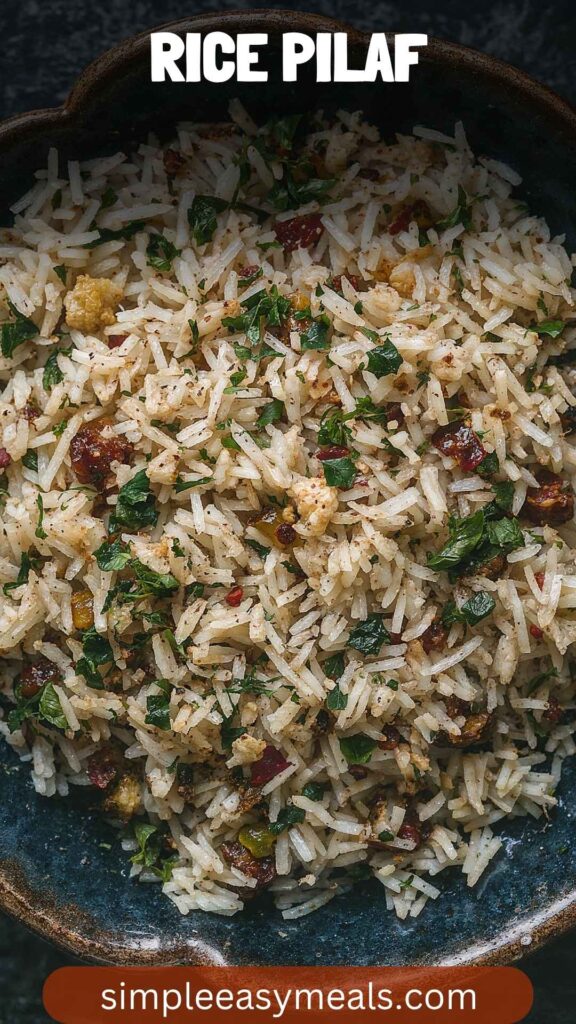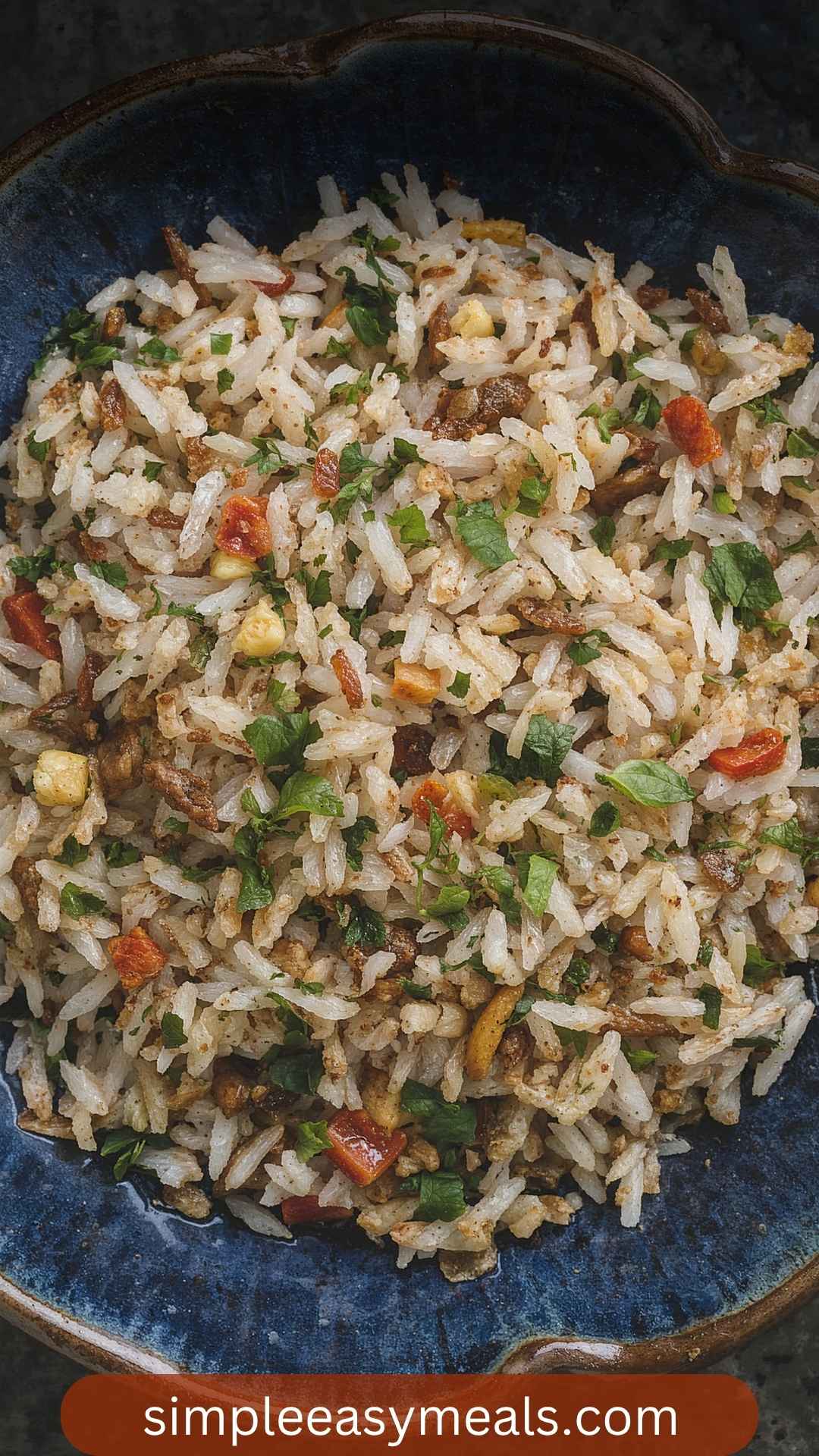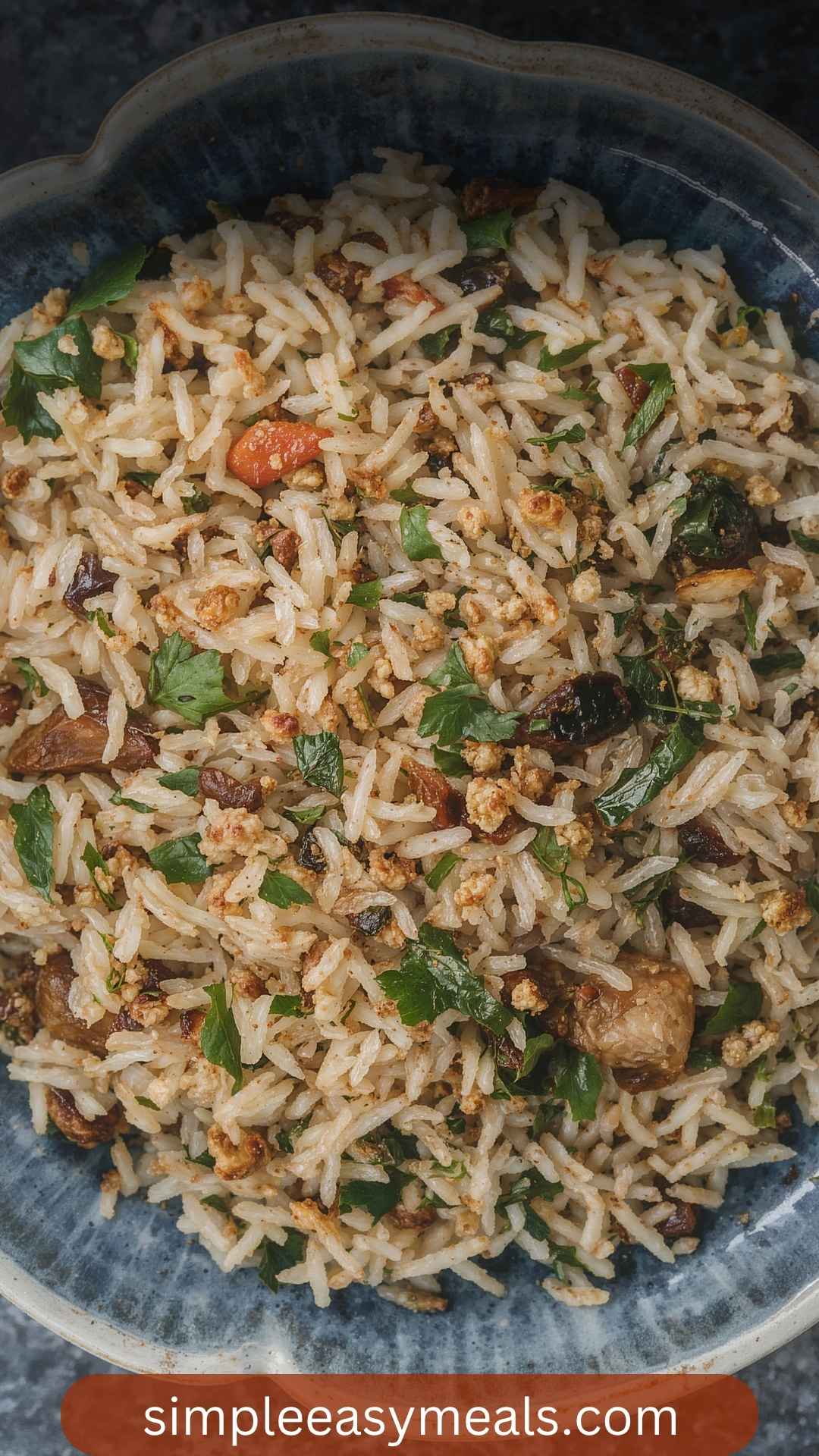Rice pilaf pairs perfectly with roasted vegetables like zucchini, bell peppers, and carrots. Their natural sweetness and slight char enhance the pilaf’s nutty flavor. Together, they create a warm, comforting plate.
Grilled chicken or fish marinated in lemon and herbs adds lean protein and bright flavors. This pairing balances the dish and keeps it light yet satisfying. The smoky grill notes complement the pilaf’s spices.
A refreshing lentil salad offers protein and zest with a lemon dressing. It adds nutrition and a vibrant contrast. A cool yogurt sauce with cucumber and garlic brightens the meal, providing a creamy, refreshing touch.
What is Rice Pilaf?
Let’s start at the very beginning. Rice pilaf, also known as pilau or pilav, is a dish made from rice and spices, often cooked in broth.
Unlike plain rice, pilaf is characterized by its savory flavor and fluffy texture. You might find it adorned with vegetables, nuts, or dried fruits, adding a delightful crunch or sweetness to each bite.
The key distinction is that pilaf involves sautéing either the rice or its aromatics before adding the liquid. This step helps to develop a flavor that plain boiled rice simply can’t match.
It’s a dish that has traveled through time and borders, with roots tracing back to the Middle East and South Asia.
Why This Recipe Works
When it comes to rice pilaf, a few fundamental elements guarantee success. Here’s what makes this recipe truly shine:
1. Simple Ingredients: The beauty of rice pilaf lies in its straightforward components. You don’t need fancy ingredients to create a dish that impresses. A handful of staples from your pantry can turn into something delightful.
2. Flavor Depth from Sautéing: Taking the time to sauté onions, garlic, and spices develops rich flavors. When you let them release their essences, the base of your pilaf becomes aromatic and deeply satisfying.
3. Versatile Customization: This recipe is your canvas. Want to throw in some peas or swap the rice for quinoa? Go for it! The beauty of pilaf is its adaptability. Each time you make it, you can tailor it to your taste buds or dietary restrictions.
4. Healthy and Wholesome: With whole grains at its core and the option to add an array of vegetables, rice pilaf is as healthy as it is delicious. Whether you're serving it up to kids or adults, it packs in nutrients without sacrificing flavor.
Ingredients You'll Need To Make This Rice Pilaf
Here’s the lineup for this rice pilaf masterpiece. These ingredients create a symphony of flavors and textures, working harmoniously together in every bite.
- 1/2 cup freshly chopped flat-leaf parsley
- 2 teaspoons extra virgin olive oil
- 2 teaspoons kosher salt
- 1/2 cup diced yellow onion
- 2 cups long-grain white rice
- 1/4 teaspoon freshly cracked black pepper
- Up to 4 cups chicken broth or vegetable broth, or a blend of water and broth
- 1/8 teaspoon cayenne pepper
- 1/2 cup finely chopped celery
- 1 teaspoon minced garlic
How To Make Rice Pilaf?
Get your apron on, and let’s dive into the cooking process. You’ll find it's a series of easy steps that lead to a warm bowl of pilaf.
Step 1: Sauté the Aromatics
In a large saucepan, heat the olive oil over medium heat. Once hot, toss in the diced onion and chopped celery. Stir frequently, allowing them to soften, about 5 minutes. The smell will start filling your kitchen. In a small way, it feels like magic.
Step 2: Add Garlic and Spices
Once the onion becomes translucent and friendly, add the minced garlic and stir for about 30 seconds. Next, sprinkle in the kosher salt, black pepper, and cayenne pepper. The combination will awaken your senses and prepare your taste buds for what's next.
Step 3: Toast the Rice
Now comes an important step: toss in the rice and stir it into the vegetable mixture. Let it toast for about 2 to 3 minutes. You want it to absorb those comforting flavors. The rice should begin to look slightly translucent around the edges.
Step 4: Pour in the Broth
Here’s where the magic happens. Gradually add the broth, ensuring you stir everything together. Increase the heat to bring it to a gentle boil.
Step 5: Simmer Away
Once boiling, cover the pot and reduce the heat. Let it simmer for about 18-20 minutes. Avoid the urge to lift the lid and peek! The steam needs to work its wonders.
Step 6: Let It Fluff
When the time is up, remove the pot from heat but leave the lid on for another 5 minutes. After that, fluff the rice gently with a fork. As you do this, you’ll notice how the pilaf transformed—fluffy and airy.
Step 7: Garnish and Serve
Finally, stir in the chopped parsley before you serve. That burst of green not only looks beautiful but adds freshness. Spoon the pilaf into bowls, and enjoy!
Tips
Here are some handy tips to elevate your rice pilaf game:
- Rinse the Rice: Rinsing the rice before cooking removes surface starch, leading to a fluffier texture.
- Use Homemade Broth: If you have time, homemade broth adds layers of flavor compared to store-bought.
- Mix in Vegetables: Throw in peas, bell peppers, or carrots towards the end of cooking for added color and nutrition.
- Garnish Smartly: Nuts like almonds or pine nuts make an excellent topping for added crunch.
- Adjust Spice Levels: If you prefer less heat, skip the cayenne altogether or substitute it with a milder spice.
How to Store the Leftovers?
Leftover pilaf? No problem! Here’s how to store it correctly:
- Cool it down: Allow the pilaf to reach room temperature before storing it.
- Sealed container: Place it in an airtight container to keep it fresh.
- Refrigerate: It can last for up to 3-5 days in the fridge, making it perfect for meal prep.
- Reheat properly: When reheating, add a splash of water to the container for added moisture.
Recommended Side Dishes for Rice Pilaf
Now that your pilaf is ready to shine, you might wonder what to serve it with. Here are a few lovelies that pair perfectly.
Crispy Roasted Brussels Sprouts: Toss Brussels sprouts with olive oil, salt, and a hint of balsamic vinegar, then roast until crispy. The bitterness balances the sweetness of the pilaf.
Garlic Lemon Shrimp: Sauté shrimp with garlic, lemon juice, and parsley for a zesty protein option. The tang complements the rice beautifully.
Chickpea Salad: Create a refreshing salad with chickpeas, cucumbers, and a lemon dressing. The textures combine well, making for a protein-rich meal.
Cucumber Yogurt Salad: Cool yogurt mixed with diced cucumbers and a sprinkle of dill can refresh the palate. It’s an excellent way to offset the spices in the pilaf.
Substitutes for Ingredients
If you find yourself out of a component, fear not! Here are some alternatives:
Rice: Don’t have long-grain rice? Use basmati rice or even quinoa for a grain-free option.
Broth: Out of chicken broth? Vegetable broth works just as well, and water mixed with bouillon cubes can be a lifesaver.
Parsley: Try fresh cilantro or even shredded kale for a bit of greenery.
Olive Oil: If you’re out of olive oil, any neutral oil such as canola or avocado will work.
Conclusion
Rice pilaf is more than just a side dish; it’s a symbol of culinary tradition, versatility, and nourishment. It invites friends and families to gather around, sharing hearty meals and fantastic conversations.
With its simple ingredients and easy preparation, pilaf is a declaration that wholesome cooking can be accessible to everyone.
So, the next time you're in the kitchen, give rice pilaf a try. It might just become your go-to dish for any occasion, whether it's a casual dinner or a celebrated feast. Happy cooking!
You’ll also like the following recipes!





